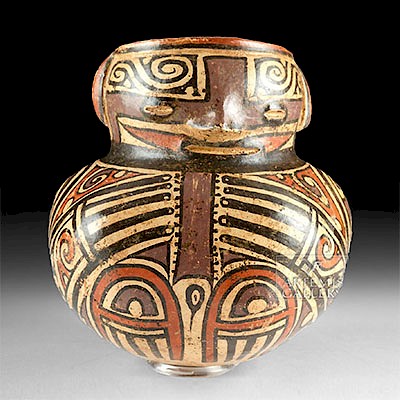Tell Halaf Pottery Seated Fertility Figure
Lot 36a
About Seller
Artemis Fine Arts
686 S Taylor Ave, Ste 106
Louisville, CO 80027
United States
Selling antiquities, ancient and ethnographic art online since 1993, Artemis Gallery specializes in Classical Antiquities (Egyptian, Greek, Roman, Near Eastern), Asian, Pre-Columbian, African / Tribal / Oceanographic art. Our extensive inventory includes pottery, stone, metal, wood, glass and textil...Read more
Estimate:
$800 - $1,200
Absentee vs Live bid
Two ways to bid:
- Leave a max absentee bid and the platform will bid on your behalf up to your maximum bid during the live auction.
- Bid live during the auction and your bids will be submitted real-time to the auctioneer.
Bid Increments
| Price | Bid Increment |
|---|---|
| $0 | $25 |
| $300 | $50 |
| $1,000 | $100 |
| $2,000 | $250 |
| $5,000 | $500 |
| $10,000 | $1,000 |
| $20,000 | $2,500 |
| $50,000 | $5,000 |
| $100,000 | $10,000 |
| $200,000 | $20,000 |
About Auction
By Artemis Fine Arts
Nov 8, 2018
Set Reminder
2018-11-08 10:00:00
2018-11-08 10:00:00
America/New_York
Bidsquare
Bidsquare : Ancient / Ethnographic From Around The World
https://www.bidsquare.com/auctions/artemis-gallery/ancient-ethnographic-from-around-the-world-3598
Ancient art from Egypt, Greece, Italy and the Near East, as well as Asian, Pre-Columbian, Native American, African / Tribal / Oceanic, Spanish Colonial, Russian Icons, Fine art, much more! Artemis Fine Arts info@artemisgallery.com
Ancient art from Egypt, Greece, Italy and the Near East, as well as Asian, Pre-Columbian, Native American, African / Tribal / Oceanic, Spanish Colonial, Russian Icons, Fine art, much more! Artemis Fine Arts info@artemisgallery.com
- Lot Description
Ancient Near East, Anatolia (central Turkey) or northern Syria, Tell Halaf area, ca. 6500 to 4500 BCE. A petite terracotta fertility figure depicting a seated woman with a singular nubbin-shaped breast, voluptuous thighs, and wide hips which emphasize her fruitfulness. The figure is posed in a slight forward lean with curving arms placed gently atop her knees. Her minimalist head boasts a thick neck and a tall, pinched face which is characteristic of abstract figures from this region. Traces of brown or black pigment remain around her neck, waist, and hands. A very strong and remarkably early example! Size: 2.2" W x 3.2" H (5.6 cm x 8.1 cm).
As early as the 7th millennium BCE, cultures in the Near East began creating organized settlements with highly developed religious as well as funerary practices. The Halaf culture of Anatolia (central Turkey) and northern Syria produced mesmerizing female figurines with fertility attributes. Whether images like these were intended to represent real, ideal, or divine women is unknown; however, scholars believe that their primary purpose was to encourage female fertility.
For a stylistically-similar example, please see The Brooklyn Museum, accession number 1990.14: https://www.brooklynmuseum.org/opencollection/objects/124145
Provenance: private East Coast, USA collection
All items legal to buy/sell under U.S. Statute covering cultural patrimony Code 2600, CHAPTER 14, and are guaranteed to be as described or your money back.
A Certificate of Authenticity will accompany all winning bids.
We ship worldwide and handle all shipping in-house for your convenience.
#137624Figure repaired from multiple large pieces with light resurfacing and overpainting along break lines. Losses to part of head, one foot, and one breast, with minor nicks across most surfaces, and fading to original pigmentation. Nice earthen deposits throughout. Two old inventory labels on verso.Condition
- Shipping Info
-
All shipping is handled in-house for your convenience. Your invoice from Artemis Gallery will include shipping calculation instructions. If in doubt, please inquire BEFORE bidding for estimated shipping costs for individual items.
-
- Buyer's Premium



 EUR
EUR CAD
CAD AUD
AUD GBP
GBP MXN
MXN HKD
HKD CNY
CNY MYR
MYR SEK
SEK SGD
SGD CHF
CHF THB
THB
















